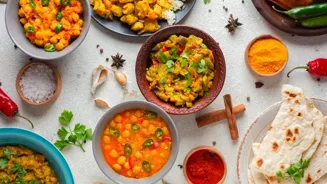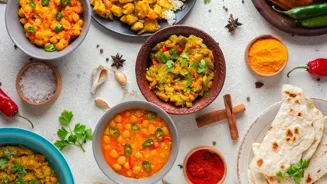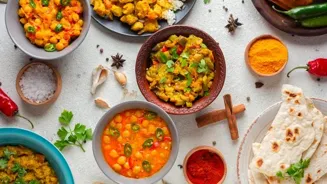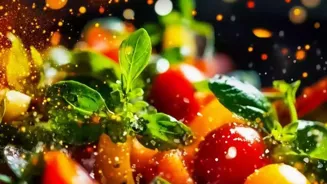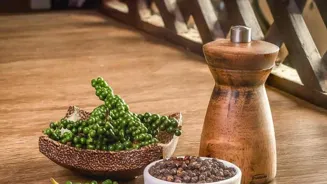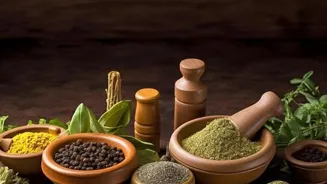Master the Art of Making Crispy Dosas: Essential Tips and Tricks for Perfect Results! Read on for dosa perfection!
For many Indians, a crispy, golden dosa is the ultimate comfort food. Whether it's enjoyed
for breakfast, lunch, or dinner, this South Indian staple is a crowd-pleaser. But achieving that perfect dosa – the one that's thin, crispy, and evenly cooked – can be a bit of a challenge.
Fear not, aspiring dosa makers! This article will provide you with essential tips and tricks to master the art of dosa making in your very own kitchen. Get ready to impress your family and friends with dosas that rival your favorite restaurant's!
Perfecting dosa batter: key ratios, ingredients, and cleanliness
The foundation of a great dosa lies in the batter. This is where patience and precision are key. The classic dosa batter is made from rice and urad dal (black lentils), soaked, ground, and fermented.
The ratio of rice to urad dal can vary slightly depending on personal preference, but a good starting point is 3:1 or 4:1. Using good quality ingredients is very important. Choosing the right kind of rice and urad dal makes a difference.
Some people prefer parboiled rice for a crispier dosa, while others opt for regular rice for a softer texture. Experiment and see what works best for you. Remember to wash the rice and dal thoroughly before soaking to remove any impurities. This ensures that the flavors are fresh and clean. Cleanliness is very important when making the dosa batter
Fermentation process crucial for dosa's flavor and texture
Next, let's talk about the fermentation process. This is where the magic happens! Proper fermentation not only gives the dosa its distinctive tangy flavor but also helps create the airy texture that's essential for crispiness. The ideal fermentation time depends on the weather.
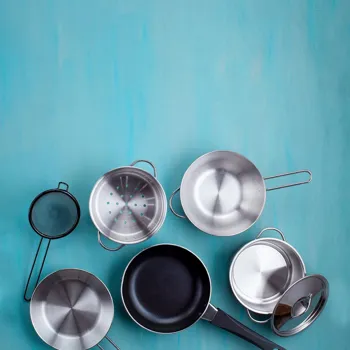
In warmer climates, the batter might ferment in 8-10 hours, while in colder regions, it might take up to 24 hours. Keep the batter in a warm place to encourage fermentation. You'll know the batter is ready when it has increased in volume and has a slightly sour smell.
Don't over-ferment the batter, as this can make the dosas too sour. Once fermented, gently mix the batter without deflating it too much. Add salt to taste just before making the dosas. Adjust the consistency of the batter by adding water if needed. It should be pourable but not too watery.
Cooking a crispy dosa requires right temp, technique, seasoning, and oil
Now comes the crucial part: cooking the dosa. The key to a crispy dosa lies in the right temperature and the right technique. A well-seasoned cast iron griddle or a non-stick pan is essential.
The griddle should be hot enough so that when you sprinkle water on it, it sizzles and evaporates immediately. Grease the griddle with a thin layer of oil. This prevents the dosa from sticking and helps it crisp up nicely.
Pour a ladleful of batter onto the hot griddle and spread it quickly and evenly in a circular motion. Make sure the dosa is thin and even. Drizzle a little oil around the edges of the dosa. This helps it release easily and become extra crispy.
Cook the dosa over medium heat until the bottom is golden brown and crispy.
Make crispy dosas by flipping and folding with care
Remember to use a flat spatula to gently loosen the edges of the dosa before flipping it. Flip the dosa and cook the other side for a shorter time, until it's lightly golden. Fold the dosa in half or roll it up, and serve it hot with your favorite accompaniments.
Some popular options include sambar (a lentil-based vegetable stew), coconut chutney, and tomato chutney. With practice, you'll become a dosa-making pro in no time. The satisfaction of creating a perfectly crispy dosa from scratch is truly rewarding.
So, gather your ingredients, follow these tips, and get ready to enjoy a delicious and crispy dosa experience! Happy cooking!
Perfect dosa requires understanding fermentation & cooking techniques for crispy texture
Achieving dosa perfection is not just about following a recipe; it's about understanding the science behind it. The fermentation process, for example, is crucial for developing the characteristic sour flavor and airy texture of the dosa.
During fermentation, microorganisms break down the carbohydrates in the rice and urad dal, producing lactic acid and carbon dioxide. The lactic acid contributes to the tangy flavor, while the carbon dioxide creates small bubbles that make the batter light and airy.
This airy texture is what allows the dosa to become crispy when cooked. The temperature of the griddle is also critical. A hot griddle ensures that the batter cooks quickly and evenly, preventing it from becoming soggy. The oil helps to conduct heat and create a crispy surface.
Maintain ideal dosa batter consistency for perfect dosas
Maintaining a consistent batter consistency is also important. If the batter is too thick, the dosa will be thick and dense. If it's too thin, the dosa will be difficult to spread and may tear easily. The ideal batter consistency should be pourable but not watery.
You can adjust the consistency by adding water as needed. Another important factor is the quality of the ingredients. Use good quality rice and urad dal for the best results. Freshly ground spices also add a lot of flavor to the dosa.
Experiment with different types of rice and urad dal to find your perfect combination. Some people add a small amount of fenugreek seeds (methi seeds) to the batter, which helps to improve the texture and flavor of the dosa. Finally, remember to be patient and practice!
Dosa making is an art, and it takes time to master. Don't be discouraged if your first few attempts aren't perfect. Keep practicing, and you'll eventually achieve dosa perfection.
Master dosa-making by adjusting water based on weather and using a seasoned griddle
Mastering the art of dosa-making requires more than just following a recipe. It involves understanding the nuances of the process and adapting to different conditions.
Factors like humidity, temperature, and even the type of water you use can affect the fermentation process and the final outcome of your dosas. One helpful tip is to adjust the amount of water you add to the batter based on the weather.
In humid conditions, you may need to add less water, as the batter tends to become thinner naturally. In dry conditions, you may need to add more water to achieve the desired consistency. Another tip is to use a well-seasoned griddle.
A well-seasoned griddle creates a non-stick surface that helps prevent the dosa from sticking and tearing. To season a new griddle, simply heat it over medium heat and rub it with oil. Repeat this process several times until the griddle has a smooth, non-stick surface.
Experiment with dosa variations for a crispy, flavorful twist
Experiment with different variations of the classic dosa recipe. Try adding a small amount of semolina (sooji) or flattened rice (poha) to the batter for a crispier texture. You can also add chopped onions, green chilies, and coriander leaves to the batter for a flavorful twist.
For a healthier version of the dosa, use brown rice or millets instead of white rice. These grains are rich in nutrients and fiber, and they add a nutty flavor to the dosa. Dosa is so easy to cook in the morning and tastes amazing with coconut chutney.
You can also explore different fillings for your dosas. Potato masala is a classic filling, but you can also use other vegetables, lentils, or even paneer (Indian cheese). The possibilities are endless! The taste of dosa gets even better when you eat it with your hand.
Properly clean your griddle for non-stick maintenance and perfect dosas every time
Cleaning your griddle properly is essential for maintaining its non-stick properties and ensuring that your dosas continue to come out perfect every time. After each use, allow the griddle to cool down completely before cleaning it.
Avoid using harsh detergents or abrasive cleaners, as these can damage the seasoned surface. Instead, use a soft sponge or cloth and warm, soapy water to gently scrub away any food residue. For stubborn stains, you can try using a mixture of baking soda and water.
Apply the mixture to the stain and let it sit for a few minutes before scrubbing it off. Rinse the griddle thoroughly with water and dry it completely before storing it.
Maintain griddle with oil, seasoning, and storage for longevity
Applying a thin layer of oil to the griddle after cleaning can help prevent rust and maintain its non-stick properties. Store the griddle in a dry place to prevent rust. If you're using a cast iron griddle, it's important to season it regularly.
Over time, the seasoned surface can wear down, so it's important to re-season it to maintain its non-stick properties. To re-season the griddle, simply heat it over medium heat and rub it with oil. Repeat this process several times until the griddle has a smooth, non-stick surface.
With proper care and maintenance, your griddle will last for years and will help you create perfect dosas every time. Dosa is a simple, light food and doesn't leave your belly heavy. It is loved by all age groups from kids to elders.
Perfect dosa: art of presentation with chutneys, sambar, herbs
Serving the perfect dosa is akin to presenting a work of art. It is not just about the taste but also about the presentation. Place the dosa attractively on a plate, garnished with fresh herbs like coriander or curry leaves. Serve it hot, as the crispness diminishes with time.
Accompany it with a selection of chutneys - coconut, tomato, and coriander-mint are popular choices. Sambar, the lentil-based vegetable stew, complements the dosa perfectly, providing a flavorful and nutritious accompaniment.
The combination of crispy dosa, tangy sambar, and flavorful chutneys creates a symphony of flavors that is sure to delight your taste buds.
Elevate dosa dining with thoughtful accompaniments and festive platters
Think about the presentation of the accompaniments. Serve the chutneys in small bowls, arranged neatly around the dosa. Garnish the sambar with a sprig of coriander. These small touches can elevate the dining experience and make your dosas even more enjoyable.
For a festive occasion, you can even create a dosa platter with different types of dosas, such as masala dosa, cheese dosa, and paneer dosa. This is a great way to showcase your dosa-making skills and impress your guests.
Remember the essence of Indian hospitality is serving with love and care which is the best. Remember, making dosas is a journey, so enjoy the process and savor the delicious results.
AI Generated Content. Glance/InMobi shall have no liability for the content